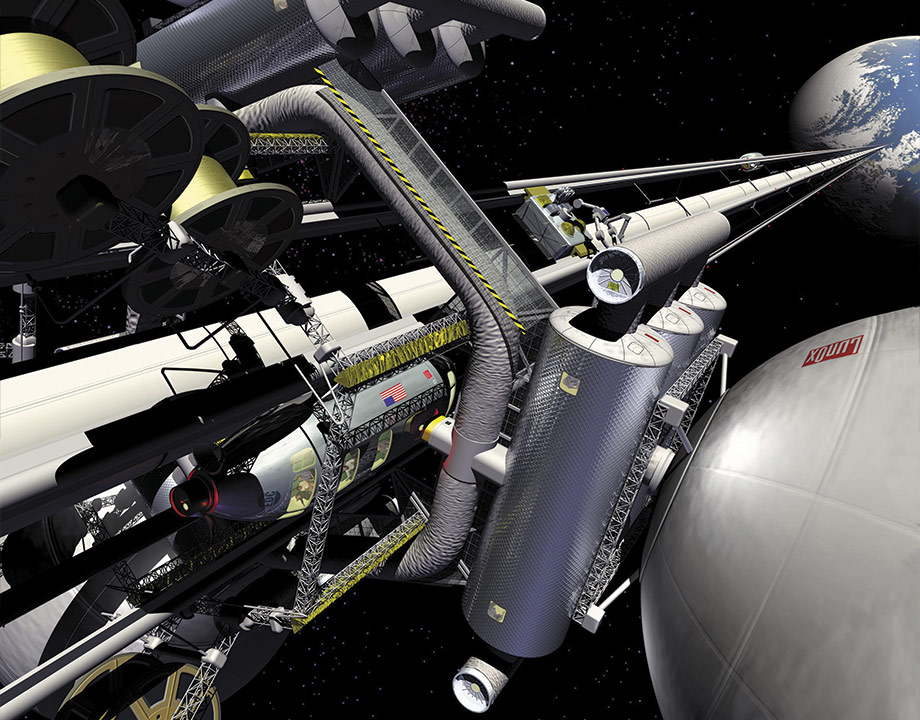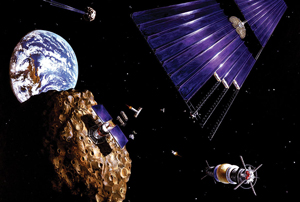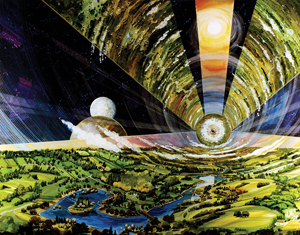Apollo: 500 Years After
Apollo: 500 Years After


Special vehicles may someday climb up a 35,000-km long ribbon to and release payloads into orbit. Such space elevators would radically bring down the cost of launch. Image: NASA
The dignitaries in spacesuits stood in a moment of radio silence, gazing across the powdery, footprint-marked field of Tranquility Base Monument. After an interval, Neil Armstrong’s familiar lines crackled through the radio. It was exactly 500 years to the moment that he first said those words.
If the Moon landing in 1969 was a cause for worldwide awe, the 500th anniversary in 2469 was somewhat subdued. It’s not that space exploration had become unimportant over the intervening centuries—quite the opposite. The problem was that space technologies were so commonplace and so critical to human society that it was impossible for anyone alive to fully appreciate the triumph.
After the commemoration, the invited guests returned to homes shaped by space engineering far beyond what the Apollo engineers could accomplish, but which had been foreseen in the first decades after the first Moon landing.
Listen to the podcast about the Engineering of the Lunar Module
Representatives from Alaska, Finland, and Patagonia returned to a planet unbreakably linked to space. For instance, the economies of those countries relied on electric power beamed from orbiting stations. Those stations, glinting like diamonds in geostationary orbits that are rarely eclipsed by the Earth, collect solar radiation with kilometers-wide arrays and then convert that power to microwave radiation that gets beamed to antennas on the surface. The clean and virtually limitless power from these satellites helped stand economic theories on their heads; humanity lived in an era of abundance, not scarcity.
Another connection to space was more tangible.
Enormous ribbons of crystalline graphite reached from port facilities along the equator to massive counterweights in orbit. Used as space elevators, they reduced the cost of lifting mass into space by orders of magnitude, though they suffered from being relatively slow—it might take a week for a cargo pod to climb into geostationary orbit.
The physics and economics of space elevators also shaped the flow of goods. Since it was much easier to send mass up than to bring it back down, massless power and data were the main products sent from space. The traffic on the space elevators only went up.
When humans travelled to and from orbit, however, they still used spacecraft that were little changed from the ones developed in the early 21st century.
Other VIPs had longer trips home. Fusion-powered propulsion systems allowed for quicker trips through the solar system than was possible via the rockets used in the Apollo era. Even so, getting from Earth to near-Earth asteroids or Mars could take weeks.
While early visionaries imagined cities on the surface of Mars or the moon, the first outposts in those places faced debilitating challenges—the economic hardships of living on Mars were as severe as the Martian climate. The habitat of choice for humans turned out to be giant pressurized cylinders, spheres, and tori that spun to create gravity. The interiors of these spinning settlements were maintained to provide pleasant weather and beautiful landscapes that were often more pleasing than what remained on Earth.
Many of these settlements had been built close to resource-rich asteroids to take advantage of their raw material. Asteroids had proven to be such valuable sources of both metals and water that the settlers often were far wealthier than humans remaining on Earth.
At one of the largest and richest settlements, robotic assemblers and human engineers were at work building the most ambitious project ever. Construction had started as soon as a probe had sent back signals from a nearby star system, showing water-rich planets and abundant asteroids. When completed, the starship and its human crew would begin the longest journey ever attempted. If all went according to plan, some day people in our solar system would be able to watch astronauts from the Armstrong walk on a world in another star system.
One of the astronauts might even plant a flag.
While the story of the world in 2469 seems far out, the key enabling technologies are being developed right now. Here’s the state of development for space elevators, power satellites, asteroid mining, interplanetary propulsion, and space settlements.
Space Elevator
Many engineers see the cost of delivering a payload to orbit as the biggest single stumbling block to developing space resources. Existing launch systems cost several thousand dollars per kilogram to get a payload into low Earth orbit. Companies that build partly reusable rockets, such as SpaceX, are aiming to get costs down in the $900-per-kg range—better, but still high.
The ultimate solution may be to ditch rockets altogether. The concept of a so-called space elevator was invented independently in the 1960s and 1970s by Russian Yuri N. Artsutanov and American Jerome Pearson. Pearson calculated that a sufficiently strong tether could stretch from the Earth’s surface to geosynchronous orbit and beyond; specially built vehicles could climb up that ribbon and release payloads into space. It would take a week to get to geosynchronous orbit, but the cost savings would be worth it.
“You’re not going to get to $50 a kilogram using rockets,” said Peter Swan, a mechanical engineer who is the chief operations officer of Zodiac Planetary Services in Paradise Valley, Ariz. “For routine launches on the order of 20 metric tons a day, you need a space elevator.”
For decades, the concept foundered on the lack of a material capable of holding together as it dangles more than 35,000 km, but according to Swan, new carbon-based materials such as single-crystal graphene seem to have the requisite strength—in theory.
“We are on the path to tech-readiness,” Swan said. “What we need now is industry testing.” One test has already begun: Researchers from Shizuoka University in Japan last year sent an experiment to the International Space Station to test some of the principles of an object climbing a tether in space, though its 11-m tether is made of steel.
Swan is confident that before the end of this century, the first space elevator will be operating. By 2469, he believes, the people of Earth will see space elevators as freight railways to the sky.
Power Satellites
Solar power is getting cheap, but it still can only generate electricity when the sun is up. That limitation led engineer Peter Glaser to develop (and patent in 1973) the concept of putting acres of solar panels on satellites in geosynchronous orbit and beam the power down to receiving stations on the Earth’s surface.
It’s a simple idea, and according to John C. Mankins, a former NASA physicist currently working in private space development, all the basic components have already been tested and are technologically ready. “They haven’t been demonstrated in space applications,” Mankins said, “but they’ve been demonstrated in terrestrial use or in the laboratory.”
Editor’s Pick: The Race for Space Weapons
For instance, Mankins said, beaming power to an antenna via microwaves was demonstrated in the lab in 1973, with a receiver efficiency above 90 percent. More recently, solid state power electronics have been developed to allow the transmitters to work with fewer losses.
The first megawatt-scale demonstration could occur as early as the 2030s, Mankins said. Beyond that, the stumbling block is launch costs, which at present make the cost of power unaffordable. Until cheaper launches are available, the only way to get a large-scale power satellite system in place is by building them in orbit from space-based materials, which might not be possible for some decades, as the industrialization of space is still in its infancy.
A constellation of power sats would help supplement Earth-based renewables, but Mankins says that such a power system might have the most value in space. “You can process materials, you can mine asteroids, you can do very high power beaming of energy,” Mankins said. “If you have megawatts of power at low cost in space—and other spacefaring countries don’t—you win.”
Asteroid Mining
Some entrepreneurs see space as the ultimate motherlode. One frequently cited estimate suggests the value of minerals in the asteroid belt exceeding $700 quintillion, or $100 billion for every person currently living on Earth.
Presented with the possibility of the grand-daddy of all gold rushes, private companies—with names like Planetary Resources, Deep Space Industries, and Planetoid Mines Company—are already looking to exploit those riches. Planetary Resources, for instance, announced in 2016 that it was developing a privately funded program to send a probe to an asteroid to prospect for minerals, with a launch date scheduled for next year. If all goes well, it—or one of its several competitors—could begin exploiting minerals by before the end of the next decade.
Exactly how to get at those minerals remains debatable. One scheme would send entire robotic processing plants to deep space to extract the valuable minerals—and volatiles such as water—which would then be shipped back to Earth. Another would hitch so-called space tractors to small asteroids and pull the whole object to Earth orbit to be mined.
While the mineral wealth of the moon and asteroids may be beyond human imagination, it’s unlikely that it will replace resource extraction on Earth itself. The complication is how to bring tons of minerals down from Earth orbit in a safe and cost-effective way; a mistake would produce an out-of-control meteor.
According to Peter Swan of Zodiac Planetary Services, technologies such as a space elevator could support an inexpensive flow of material into orbit, but economically important space commodities will either stay in space or be massless like power or communications.
“Coming back is a real bear,” Swan said. “Space mineral resources are going to be used in situ. They are more valuable out where they are.”
Interplanetary Propulsion
Getting to low orbit is a challenge today, but to fully explore—and exploit—the solar system, future generations will need a better way of crossing interplanetary space.
Rockets have a severe limitation: They must carry their own fuel, which adds mass to a spaceship, which then requires more fuel. To get a sense of the tooth-to-tail challenge, the 3,600 kg Juno probe now orbiting Jupiter was launched in 2011 by an Atlas V rocket loaded with 518,000 kg of fuel. And it still took five years to reach its destination.
One approach to beating this problem is to create more efficient engines. A space-borne nuclear reactor (either fission- or fusion-based) could accelerate ionized gas particles either by heating the fuel directly in the reactor or by applying magnetic fields. Expelling this plasma at high speed, an atomic rocket would have a large specific impulse—the measure of rocket efficiency.
In the next century, even more exotic propulsion systems may be developed. The tip of a space elevator tether that extended 50,000 km from the surface of the Earth would whip around at escape velocity; a ship released from that point would just need a slight boost to reach Mars or beyond.
Another concept currently being tested is a solar sail: LightSail 2, a CubeSat experiment, which was launched in June. Its large, lightweight, shiny surface would reflect the intense sunlight hitting it. The reflected sunlight carries enough energy to cause the sail to accelerate ever-so slightly. The effect is small, but according to one early 1990s study, over time a spaceship equipped with a solar sail could reach more than 17 km per second, fast enough to reach Jupiter in less than two years.
Space Settlements
Ultimately, space will become a home for humanity. But where is the best place to settle?
For nearly a century, people have had a vision of colonizing the Moon or Mars. But as robotic rovers collect more data about the surfaces of those worlds, they have become less inviting.
An alternative was proposed by Princeton physicist Gerard K. O’Neill in the mid-1970s: spinning orbiting settlements that would produce artificial gravity via centripetal force and admit sunlight through shielded windows. O’Neill envisioned very large settlements as homes to workers who would build and maintain power satellites by the late 1990s, giving these sky towns an economic rationale.
“It was considerably more ambitious than Apollo,” said Al Globus, a senior research associate at San Jose State University, “but it suited the mood of the time.”
Although O’Neill’s original timeline has come and gone, Globus and others are still developing plans for settlements. Beginning with essentially space hotels that would be a destination for tourists, organizations could build progressively larger structures for long-term housing in space. Globus recently published a blueprint for a first-generation settlement stationed in low orbit along the equator that would take advantage of the Earth’s magnetic field to shield residents from cosmic radiation. His Kalpana One would house fewer than 150 people and would require artificial lighting.
“You have to build it stronger than a hotel because it has to rotate faster,” Globus said. “If all goes well, maybe 30 years from now the first settler moves in.”
In time for the 500th anniversary of the Apollo 11 Moon landing, however, much larger settlements would likely be built, either in Earth orbit or in interplanetary space near resource-rich asteroids. If the technology can be perfected, there’s no reason to believe that the sky will be humanity’s limit.





